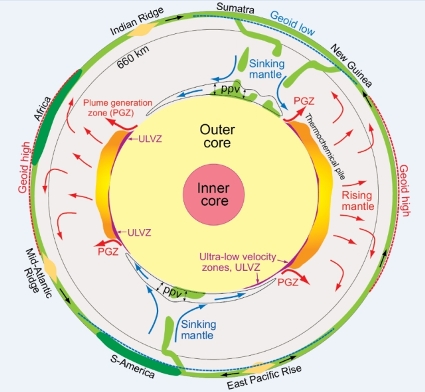New Study Illustrates Ways Earth Keeps Its Balance
A study published in the science journal Nature, highlights the discovery that large-scale upwelling within Earth's mantle mostly occurs in only two places: beneath Africa and the Central Pacific. Although we witness large shifting events as the result of subduction zones producing earthquakes, volcanoes, and tsunamis - somehow Earth manages a way to keep from flipping. A full tilting of Earth's axis is often referred to as "True Pole Wander". This refers to credible scientific studies which formulate that if an object of sufficient viscosity - such as Yellowstone were to fully erupt, the shifting of land mass would be enough to cause a rotational imbalance. As a result our planet would tilt and rotate itself until a new equatorial balance was created. Another example to create such an event would be the collision of an asteroid the size of 5 miles (8 km) in diameter. |
|
|
Clinton Conrad, Associate Professor of Geology at the University of Hawaii and colleagues, revealed that large mantle upwelling locations such as beneath the continent of Africa and the Central Pacific have remained remarkably stable over geologic time, despite dramatic reconfigurations of tectonic plate motions and continental drifts on the Earth's surface. This research opens up a big question for solid earth scientists. What processes cause these two mantle upwelling locations to remain stable within a complex and dynamically evolving system such as the mantle? One notable observation is the lowermost mantle beneath Africa and the Central Pacific seem to be composed of rock assemblages that are different than the rest of the mantle. Is it possible that these two anomalous regions at the bottom of the mantle are somehow organizing flow patterns for the rest of the mantle? Perhaps plausible, but more research is needed. Full Article - http://bit.ly/15GnBFD |
|
Scientists Use X-rays to Connect Mantle Chemistry In this just released study, geologist the Smithsonian National Museum of Natural History, and the University of Rhode Island, analyze mid-ocean ridge basalt glass to better understand Earth's deep interior and ancient past. Samples showed that the oxidation states of iron varied from place to place depending on the mantle's characteristics - but in a way that was much different from what scientists had previously thought. |
|
|
Geologists Elizabeth Cottrell and Katherine Kelley, used x-rays produced by the National Synchrotron Light Source (NSLS) at the U.S. Department of Energy's Brookhaven National Laboratory to examine a large collection of deep-sea glass in order to uncover geochemical "fingerprints" left behind during the magma's ascent and eruption. "In our study we looked at lavas from volcanoes on the sea floor all around the globe, and we measured the oxidation state of iron," said Cottrell. "We wanted to know if that could tell us something about the history and character of the mantle that melted to make those lavas, and then froze to form the glass." Full Article - http://bit.ly/139DR7g |
Mitch Battros
Producer - Earth Changes Media
Email: newsletter@earthchangesmedia.com

